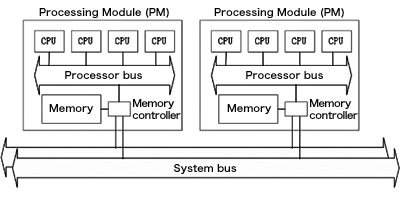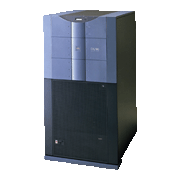These two models, both featuring RISC-based*1 SuperSPARC*2 processors, were the most advanced UNIX servers of Fujitsu’s DS/90 7000 series. They were announced jointly by Fujitsu and PFU in May 1995, along with the DS/90 7500 (I, II)/7700 (I, II, III) models, which were equipped with hyperSPARC processors.
The DS/90 7800E and 7900E offered excellent scalability thanks to a distributed shared memory design known as NUMA.*3 The servers ran Fujitsu’s UXP/DS operating system,*4 which was upgraded for enhanced NUMA support.
Features of the DS/90 7800E and 7900E:
- (1)Employed a NUMA*3 memory model
- Processing power was extended by adding processing modules (PMs), which consisted of two or four CPUs and local memory (see figure below).
The DS/90 7900E could be scaled from eight CPUs to 20 CPUs. - (2)Equipped with a system control facility (SCF), which monitored the system with an independent processor for added reliability
- CPU/PM monitoring functions
- On-board abnormal-event logging functions
- Power-supply history functions
- External monitoring and control functions
- (3)NUMA support was built into the operating system (UXP/DS)
- In distributed shared memory models, the greater the locality of memory access (that is, the percentage of accesses to the local PM memory), the better the performance and scalability. To ensure greater locality, Fujitsu added the following upgrades to UXP/DS:
- Evenly distributed the kernel code among all PMs
- All kernel modules and drivers were multithreaded so that they could run on any PM
- The PM that issued an I/O command controlled the related interrupts and process behavior
- Added a process binding methodology that permitted PM designations
- *1. RISC: Reduced instruction set computer.
*2. SPARC: Processor standard developed by SPARC International.
*3. NUMA: Non-uniform memory access. A method of efficiently sharing memory between multiple CPUs that breaks down the symmetry between CPUs and memory units to achieve better overall access performance. The greatest advantage of NUMA is that although CPUs on par with parallel processors can be employed, the application program side sees them as an SMP architecture.
*4. UXP/DS: Fujitsu’s operating system based on System V Release 4 (SVR4). SVR4 is a standard UNIX specification developed by UNIX System Laboratories and derived from AT&T’s UNIX System V.
*5. SMP: Symmetric multiprocessor. A multiprocessor architecture where multiple processors, which function identically, are connected to a single shared main memory.



